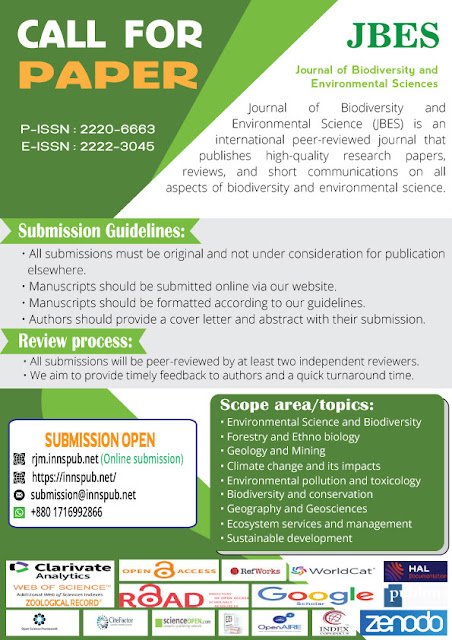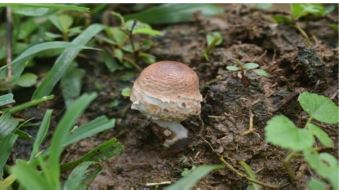Bhavana Dixit, from the
different institute of the india, wrote a research article
about, Bilaspur's Wild Mushrooms: Edible and Medicinal Diversity,entitled,
"Diversity of edible and medicinal wild mushrooms of Bilaspur District of
Chhattisgarh in Central India".This rsearch paper published by the Journal of Biodiversity and Environmental Sciences | JBES. an open access scholarly
research journal on Biodiversity, under the affiliation of the International
Network For Natural Sciences | INNSpub.an open access multidisciplinary
research journal publisher.
Abstract
India is a tropical
country with a wide range of climatic conditions; it is a natural habitat for a
large range of wild mushrooms. Chhattisgarh, which is the central part of
India, has Tropical Forests providing ideal growing conditions for diverse wild
mushrooms flora including many edible and therapeutic fungi. The present study
explores the biodiversity of naturally growing wild edible and medicinal fungi
from the different forest-associated tribal/rural areas in Bilaspur. A total of
15 species of wild edible mushrooms including 8 fungi having therapeutic
properties were collected and identified. The identified species were found
saprophytic and mycorrhizal. Moreover, the majority of popular edible mushroom species
were recorded during either the early or the late rainy season. Therefore, the
present study generated a database on mushrooms diversity in the Bilaspur
District of Chhattisgarh that will help for its sustainable management.
Read more: Tilapia By-products:Characterizing Fish Protein Hydrolysate | InformativeBD
Introduction
Wild edible fungi have
been collected and consumed by people for thousands of years but in recent
decades, there has been a surge in global interest in the utilization of wild
edible fungi (FAO 2004). Because they are a valuable medicinal, socioeconomic resource,
and food safety and, security in many parts of the globe. Wild edible fungi are
considered a healthy food because their mineral content is higher than that of
meat or fish and most vegetables (Chan, 1981). Furthermore, fresh edible fungi
have roughly twice the protein amount of veggies (Chan, 1981). They have rich
nutritional value with high content of vitamins, protein and minerals, fibers,
trace elements, and contain no or low calories cholesterol (Agahar- Murugkar
and Subbulakshmi2005; Wani et al., 2010; Okoro I.O. et al., 2012). Moreover,
many researchers have conducted nutritional analyses of various mushroom
species, finding that they are high in protein (30–48%), carbohydrate
(125–40%), fat (1– 4%), ash (7–17%), and fiber (16% - 20% ), etc. (Pushpa &
Purushothama, 2010; Manikandan, 2011). Apart from their use as food, a variety
of edible and non-edible fungi have been utilized for therapeutic purposes
(Wasser and Weis, 1999; Hobbs, 1995), as they contain a good amount of
secondary metabolites and have antioxidant, anticancer, anti-mutagenic,
antimicrobial, and antiradical properties (Barros L et al., 2007), that may
help to prevent or lessen the risk of cancer, heart disease, diabetes, and
viral infections (Oei, 1991). Moreover, the presence or absence of mushroom
species can be used to determine whether an ecosystem is degrading or
developing, they also play a crucial role in nutrient reprocessing, plant
growth, and establishment in forests (Tapwal et al., 2013). More than 2,000
fungi have been identified as producing edible sporocarps around the world
(Boa, 2004), and 283 edible species from India (Purkayastha and Chandra, 1985;
Adhikari, 2000) among them have been cultivated.
The consumption of fleshy fungi has expanded in many nations in recent years, making it necessary to investigate the treasure trove of wild mushrooms. India is a tropical country with a wide range of climatic conditions; it is a natural habitat for a large range of wild mushrooms. Chhattisgarh, which is the central part of India, has Tropical Forests providing ideal growing conditions for diverse wild mushroom flora including many edible and therapeutic fungi. The forests of this state have a high reservoir of unexplored macro-fungal wealth, as the knowledge about various edible and medicinal fungi in different tribal/rural areas has not received significant attention. Therefore, the present study has undertaken to explore the biodiversity of naturally growing wild edible and medicinal fungi from the different forest-associated tribal/rural areas in Bilaspur. This paper reports the wild edible and medicinal mushrooms diversity from Bilaspur district of Chhattisgarh, India
Reference
Adhikari MK. 2000.
Mushrooms of Nepal. Kathmandu: P. U. Printers.
Agrahar-Murugkar D,
Subbulakshmi GJFC. 2005. Nutritional value of edible wild mushrooms
collected from the Khasi hills of Meghalaya. Food Chemistry 89(4), 599-603.
Barros L, Ferreira MJ,
Queiros B, Ferreira IC, Baptista P. 2007. Total phenols, ascorbic acid,
β-carotene and lycopene in Portuguese wild edible mushrooms and their
antioxidant activities. Food Chemistry 103(2), 413-419.
Boa ER. 2004. Wild
edible fungi: A global overview of their use and importance to people.
Chakraborty I, Mondal
S, Pramanik M, Rout D, Islam SS. 2004. Structural investigation of a
water-soluble glucan from an edible mushroom, Astraeus hygrometricus.
Carbohydrate Res. 339, 2249- 2254.
Chan HKM. 1981.
Consumption of edible mushrooms in Hong Kong. Mushroom Newsletter for the
tropics 1(4), 5-10.
Chandrawati SP, Kumar
N, Tripathi NN. 2014. A macrofungal wealth of Kusumhi forest of Gorakhpur,
UP, India. American International Journal of Research in Formal, Applied, and
Natural Sciences 5(1), 71-75.
Das K. 2010.
Diversity and conservation of wild mushrooms in Sikkim with special reference
to Barsey Rhododendron Sanctuary. NeBIO 1(2), 1-13.
FAO. 2004. Wild
Edible Fungi: A Global Overview of Their Use and Importance to People. Non-Wood
Forest Products 17. Rome.
Hobbs CH. 1995.
Medicinal mushrooms: exploitation of tradition, healing, and culture. Botanica
Press. Santacruz pp. 219-251
Manikandan K. 2011.
Nutritional and Medicinal Values of Mushrooms. In M. Singh, B. Vijay, S. Kamal,
& G. C. Wakchaure (Eds.), Mushrooms Cultivation, Marketing and Consumption
11-14. Solan: Directorate of Mushroom Research.
Oei P. 1991. Manual
on mushroom cultivation: techniques, species, and opportunities for commercial
applications in developing countries.
Okoro IO, Achuba
FI. 2012. Proximate and mineral analysis of some wild edible mushroom.
African Journal of Biotechnology 11(30), 7720-7724.
Purkayastha RP, Chandra
A. 1985. Manual of Indian Edible Mushrooms. New Delhi, India: Jagendra
Book Agency.
Pushpa H, Purushothoma
KB. 2010. Nutritional Analysis of Wild and Cultivated Edible Medicinal
Mushrooms. World Journal of Dairy and Food Sciences 5, 140-144.
Singha K, Sahoo S, Roy
A, Banerjee A, Mondal KC, Pati BR. 2020. Contributions Of Wild Mushrooms
In Livelihood Management Of Ethnic. IJPSR 3160-3171.
Sun S. 2014. One
kind of traditional Chinese medicine composition for treating diabetes. China
patent application CN103550660A.
Tapwal A, Kumar R,
Pandey S. 2013. Diversity and frequency of macrofungi associated with wet
evergreen tropical forest in Assam, India. Biodiversitas 14, 73-78.
Venkatachalapathi A,
Paulsamy S. 2016. Exploration of wild medicinal mushroom species in Walayar
valley, the Southern Western Ghats of Coimbatore District Tamil
Nadu. Mycosphere 7(2), 118-130.
Wani BA, Bodha RH, Wani
AH. 2010. Nutritional and medicinal importance of mushrooms. Journal of
Medicinal Plants Research 4(24), 2598-2604.
Wasser SP, Weis
AL. 1999. General description of the most important medicinal higher
Basidiomycetes mushrooms. Int. Med. Mush 1, 351-370.
Watanabe T. 1937.
Pictorial atlas of soil and seed fungi. tsukuba, Ibaraki, Japan: CRC Press
Taylor & Francis group an informa business.












%20in%20full.JPG)


0 comments:
Post a Comment